March 3rd, 2015 — 12:43am
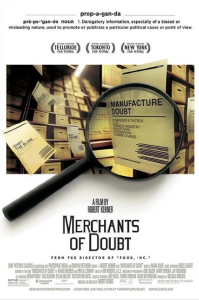 ****
****
Merchants of Doubt-sp
At the beginning of the film, we meet a magician who is performing at the Los Angeles’ venue called the Magic Castle. He relates how magicians deceive and misdirect as they perform. This, of course, is the metaphor for the work of the people we meet in this film. They work for various industries such as the Food, Tobacco and Oil Corporations. Although most of the time this fact is concealed from the public, they do deceive and misdirect in how they do it. And the fact that they do it is the amazing story of this documentary film. It is directed and produced by Robert Kenner, who also made the film Food Inc, the behind-the-scene story of the food industry. This time, Mr. Kenner mostly focuses his attention on global warming. It has become clear that the scientific community almost unanimously believes that the products of carbon dioxide create a blanket over the Earth’s environment that is causing global warming. The consequences are quite dire for the world in the next 50 years. Already, we are seeing a melting of the Arctic icecap with potential flooding of our coastal cities, colder winters and warmer summers. Before the civilized world can come together and address these serious problems, there is a group of seemingly knowledgeable spokespersons who appear to respectfully offer another viewpoint and explanation for the presence of global warming. However, these people are secretly paid by the oil industry to create uncertainty. Now is the time for action but these people are “merchants of doubt†and are highly effective in delaying, diverting and obscuring that fact and the need for action. They employ the same tactics that the cigarette industry had used to delay the recognition of the fact that nicotine is addictive and that cigarettes cause cancer. This is an amazing story, and interestingly enough, it comes from “the horse’s mouth†as much of it is directly told by the slick, well-spoken people who are operating at the bidding of the corporations who have paid them in defiance of the truth established by the scientific community. In the past when the companies in the tobacco industry were finally discovered to be deceiving the public, they were ordered by the court to inform the public of the truth about cigarettes and also to reveal that they were knowingly deceiving the public. The truth about cigarettes is now on every cigarette box and in advertisements, but we have yet to see statements from climate change deniers admitting that they have lied to the public. We can only hope that the necessity for these confessions of deceit will be forced upon those responsible for misleading the public about global warming. We also hope that a large number of people will see this film so that the truth will prevail.(2015)
Comment » | 4 Stars, Documentary
February 5th, 2015 — 8:22pm
*****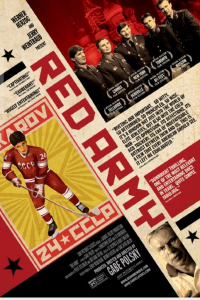
The Red Army-sp The Red Army is a film about hockey, except that it isn’t! We agreed with several people in the audience, with whom we saw this film, who stated that they had not been looking forward to this documentary about the national hockey team of the Soviet Union. However, we, like they, were entirely captivated by this incredibly well executed documentary written, directed and produced by the young filmmaker, Gabe Polsky. While much of the film showed actual footage of hockey games played by this extraordinary team, the scenes were beautifully put together between photos of early years of some of the players, magnificent interviews with a wide range of people and footage of life in the soviet union over the years. Mr. Polsky created a film that was enlightening, poignant and engaging by focusing mainly on one player, Viacheslav (Slava) Festinov and telling his story. By doing that, he told the story of the proud Russian people and their culture. He was able to explicate the determination and love of country, even in the face of adversity and lack of freedom that existed. Festinov as a young boy was like millions of other youths who wanted to play hockey and dreamt of being on his national team. Because of his skills he became part of the national hockey-training program that selects the best and vigorously trains them for several years. Through carefully constructed and interwoven interviews and film clips we come to see the total dedication to the game that these young men developed. We are introduced to the coaches who revolutionized the game by treating it on the level of complex ballet and complicated chess games, both of which the Russians had been known to be masters. We also see the unrelenting, even cruel training techniques that required total dedication and the total power that a coach with support of the government could have over the players. The film shows the fascinating years of the amazing world wide successes, then the 1980 “Miracle on Ice†in which the United States Olympic hockey team upset the Soviet Union and went on to win the Gold Medal at Lake Placid and the redoubled efforts following that loss which created a whole new “must win†era in the Soviet Union. The events that then occurred with all the twists and turns of a “must see†thriller are captured in the film keeping the viewer totally engaged. The events in Festinov’s life as well as the changes in the Soviet Union are compelling. With hockey as a platform, it is what happens in the lives of the people in this space that makes for a film that compels you to become involved. It is the best of what a good documentary does. You see, you learn and most of all you care. (2014)
Comment » | 5 Stars, Documentary, History, Sport
January 5th, 2015 — 2:44am
**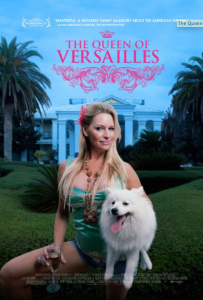
The Queen of Versailles – nf Mrs. American, a Florida beauty pageant winner marries 2nd husband David Siegel, one the richest men in the country thanks to his success selling time-shares. He is 30 years her senior and they go on to have eight children. Although they live in a mansion with nannies and other help, they set about to build the largest house under one roof in the United States. They fashion it after the Palace of Versailles and it will have more than 90,000 square feet. Their life style includes limousines, extravagant furnishings and clothes, as well as everything for their children. If there ever were a family to which the term “ life styles of the rich and famous†would apply, it would be to this one. Mr. Siegel even takes credit for election of George W. Bush by carrying Florida because of his great financial support of him (which he even acknowledges might have been a little illegal.) He owns one of the largest buildings in Las Vegas, which he turns into a time-share operation. Mr. Siegel’s timeshare selling team won’t take no for an answer and they have a time-share for every budget. Filmmaker Lauren Greenfield realizes that this couple would be a fascinating subject for a documentary film and they agree to the project. If this were the entire story, it would probably be an interesting film which would provide insight into how people with essentially unlimited money live their lives. However, this project was started a little before 2008 when the US was hit with a gigantic stock market and real estate crash. Too many Americans had “sub-prime “mortgages, meaning they held mortgages, on which they could no longer make their payments once the economy, went bad. This not only impacted the little guy, or even the average family but it affected big time, timeshare mogul David Siegel who suddenly found that he could not pay his loans. His financial world came crashing down around him. The film became the story of how this family began to deal with the sudden completely unexpected change of events for them. They had to put their unfinished dream house up on the market with nary a buyer in sight. They had to radically cut back on all their help, stop their extravagant spending and even started to have arguments about keeping unnecessary lights on in their house. Even if this is not exactly rags to riches and back to rags, it is a lesson in how people often don’t appreciate what they have and when they have it want more. While the message may have long lasting meaning, the nuances of the economy problems seem somewhat dated, the movie also feels that way. Hopefully new regulations put in place will at least protect the little guy in the future. The big boys usually fend for themselves. We did a search to find out how the folks in the film were doing today which revealed that in 2014, the filmmaker and the Siegels were suing each other for issues related to the movie. (2012)
Comment » | 2 Stars, Documentary
August 21st, 2014 — 7:00pm
****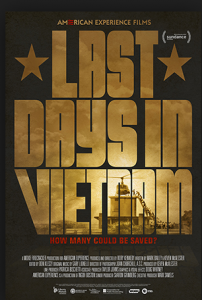
Last Days in Vietnam-sp– Even if you were around in 1975 during the U.S pullout from South Vietnam, the true story of how it went down is probably not the way you remember it. Even that iconic photograph of people climbing up a ladder into a helicopter from what you thought was the U.S Embassy was not the U.S. Embassy. Rory Kennedy, youngest daughter of the late Robert Kennedy is a documentary filmmaker who realized that there was an interesting story here to be told. Together with her co-producer Keven McAlester and their team she researched the subject, dug out archive documents and film footage, followed leads, set up interviews with former CIA agents, American soldiers, as well as Vietnamese who got out and some that didn’t. She also was able to interview one of the key surviving players who surrounded and advised President Ford during those final days. That was none other than Henry Kissinger who had been Secretary of State for both Ford and President Nixon. Nixon actually looks quite good in the view of the historical circumstances, which are presented here. It was under his watch that the peace accord of !973 was signed which was followed by the withdrawal of US Troops. We are then shown in 1975 shortly after Nixon resigned from office that the North Vietnam troops began the march towards Saigon. The implication was clearly stated that they would have been afraid to do so if Nixon were in office. We then see how President Ford was not able to get Congress to raise money to support any effort to stop this new aggression.
The real story here was the denial by U.S. Ambassador Graham Martin of the threatening attack that was underway, spilling down towards Saigon with the ultimate evacuation of all the Americans and the desperate attempt to get out bythe South Vietnamese who were connected to the Americans. Rather than use an authoritative narrator, the filmmakers chose to use the faces and the voices of the Americans and Vietnamese who lived through those harrowing days who told their own stories. The latter group knew that if they did not get out, they stood a good chance of being killed or severely punished. In fact in the final credits we learn that some of these narrators subsequently spent years in “ reeducation camps†before making their way to the United States. We learn that the final dramatic evacuation was not only by helicopter but also by sea. The helicopters flew out thousands of evacuees to a flotilla of ships led by the USS Kirk.
A good documentary often relies on some fresh views of the historical event. In this case, that was not only provided by American and Vietnamese survivors of this unusual evacuation telling their tales but also by the discovery of a box full of 8mm movie film taken by one of the sailors aboard the USS Kirk almost 40 years ago. These movies provided a vivid picture of the thousands of civilians packed aboard these ships as they attempted to get to Manila. They also showed a never to be forgotten sequence of movie scenes of a gigantic Chinook helicopter that was too large and heavy to land on the US ship. Instead the Vietnamese pilot who was trying to save his family and others had to do a remarkable maneuver where he hovered so his young children could be dropped and caught by the sailors below. He then did what experts feel was an extremely difficult task of climbing out of his pilot gear, ditching his gigantic helicopter into the sea with its spinning blades disintegrating, while he jumped out into the water and swam to safety of the nearby vessel. This amazing accomplishment was narrated by his now grown son who had been seen as one of the young children being dropped out of the Chinook.
There were several moral questions raised by this film. The big question was did the U.S. have a commitment to its ally, South Vietnam when the North Vietnamese broke the Paris Peace Accord and invaded South Vietnam. What was the meaning of the refusal of Congress to provide funds and the failure of the President to send troops back there? Did the U.S have a commitment to the many civilians and their families who had worked for the US and would be targets if they were not evacuated? Were several U.S. officers within the embassy wrong when they disobeyed orders and organized secret “ black opps†plans for evacuating civilians when the Ambassador had not authorized this to be done.? There also was a promise to all those Vietnamese who were allowed to enter the U.S. Embassy grounds for evacuation, that they would definitely be rescued. However once the Ambassador left, after most of the people were evacuated, there were 420 Vietnamese left behind who had been promised evacuation. Finally, is there any lesson here that we can glean that can be applied to the current situation in Iraq and Afghanistan where the U.S. has left and now the situation is deteriorating?
When a documentary film can prevent a fresh view of history and stir up new questions, which even pertain to our current time, we have to view it as a successful endeavor that should be seen.(2014)
1 comment » | 4 Stars, Documentary, History, War
August 16th, 2014 — 5:20pm
***
Frederick Law Olmsted: Designing America –sp If you were looking for an exciting documentary film to watch one evening, you probably would not come up with this film. You might choose one about whales, some aspect of war, the Holocaust, something related to sports or politics. Maybe you would choose Robert Reich’s Inequality for All but chances are you would not think of a film about the man who designed Central Park in New York City and a lot more. However, this very well done film by Emmy nominated husband and wife team documentary film makers Lawrence Hott and Diane Garey has the potential to give you an unforgettable perspective on the beauty and living spaces of your city as well as many other places throughout American and the world. As former New Yorkers, we have spent time over the years enjoying the beauty and comfortable space of Central Park in Manhattan and Prospect Park in Brooklyn. We assumed it was simply the original natural beauty that was preserved by our fore fathers. In actuality it was the vision of Frederick Law Olmsted who not only worked on and designed these parks with his colleague Albert Vaux but who fought to convert and build spaces into the magnificent parks with roadways, bridges, water, greenery and a backdrop of one of some of the most magnificent skylines in the world. Similarly Olmsted was also the driving force in setting up a series of parks and wonderfully designed open spaces in Buffalo, New York, which became a model for similar designs throughout the world. The setting, which encompasses Niagara Falls, was converted from a shoddy commercial exploitation to what is rightfully called one of the wonders of the world, thanks again to the work of this man. He became the planner of Boston’s “ Emerald Necklace†of green space and the creator of park systems in many other cities. He helped to make Yosemite the attractive place of beauty that millions of people have visited throughout the years. He played a major role in designing the now beautiful setting that surrounds the U. S. Capitol. He also was the site planner for the “Great White City†of the 1893 World Columbian Exposition in Chicago. This unusual story is told with fascinating old photos and breathtaking very well photographed stills and video clips. Being California people now, we especially appreciated the rich autumn colors in many of the locations that were shown. The personal history of this man and his family some of whom carried on his work is another part of the film. Showing this film in schools will not only inform young people about this subject but may also inspire some creative ones to study landscape design and perhaps carry on the tradition which is so well documented in this movie. (2014)
Comment » | 3 Stars, Documentary
August 8th, 2014 — 10:30pm
**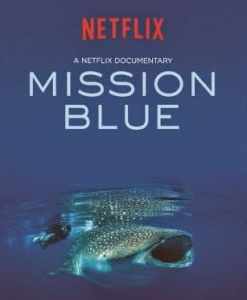
Mission Blue-sp. Dr. Sylvia Earle is truly an amazing woman. For more than 50 years she has been diving in oceans all over the world . She has been a Chief Scientist at NOAA National Ocean and Atmospheric Administration. This documentary film by Fisher Stevens (known for the award winning film The Cove) and Robert Nixon is about her but it is also about her mission in life which is to restore and save the oceans of the world along with marine life which we see is being seriously destroyed in recent years.
Unfortunately, from our point of view the focus of the film is not clear. We see breathtaking footage of life near the bottom of the ocean as underwater explorations by people like Dr. Earle and James Cameron go to record-breaking depths. We view video of Dr. Earle as a young girl and then as a young scientist evolving into a woman in her 70s who still does these dives. We briefly meet her three husbands and had an even a briefer introduction to one of her three children as a young woman. We certainly are curious to know more about her personal life which we learned in a post screening meeting with the filmmaker was also his desire to show but was not the wish of Dr. Earle.
The film clearly makes the point that a great deal of the marine life in the oceans of the world has been destroyed in recent years, apparently by over fishing, a desire by some for shark fins, and oil spills. We see what was once beautiful coral life in at least one place, is now debris. There is a dire warning that if something isn’t changed, the oxygen supply of our planet, which mainly comes from the ocean will be depleted and we might end up like Mars (which we all know is uninhabitable by humans). We are not sure what we are supposed to do. It isn’t clear if one of the messages might be not to eat too much fish. There is a plan to make “ Hope Zones†throughout the world which would be agreed upon areas of the ocean that there would be no fishing or any other activity that would disrupt life in that area of the ocean. This brain child of Dr. Earle we are told at the end of the film is making some progress. In conclusion the beautiful scenes shown are somewhat overdone and the interesting life of Dr. Earle is underdone. We are given a website at the end of the film, missionblue.org, which we hope will clarify exactly what was the mission of this movie. The film is scheduled for a brief theatrical release and then will be available on Netflix August 15th. (2014)
Comment » | 2 Stars, Documentary
July 13th, 2014 — 6:26pm
****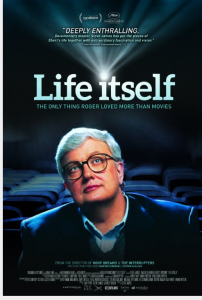
Life Itself-rm– It feels somewhat strange for us amateur reviewers to be writing a review about a documentary film centered on the most esteemed movie critic of our time. But in our opinion it is an excellent film that we would guess would receive high marks from the master himself if he were still around. He died a few months before the film was ready for release. We meet Roger at point where he is battling the cancer that has already taken away his vocal speech and altered his face. His voice via his laptop is heard and is an important part of the film. In life, his voice at this point came from a computer voice synthesizer but in the film there is a voiceover by Steven Stanton who seems to capture the inflections of Ebert’s voice as we heard it at an earlier time. Director Steve James (in 1974 Director of Hoop Dreams which Ebert had named best picture of that year) skillfully weaves video clips and interviews with various people in Ebert’s life with a flashback technique in order reconstruct this remarkable story. It becomes a special treat for the viewer to meet some other great movie critics and directors as they comment on Ebert and his work throughout the film. Such people as A.O Scott from the N.Y. Times, Pauline Kael of the New Yorker, Richard Corliss of Time Magazine and Directors Weiner Herzog and Martin Scorsese. Ebert’s talent became clear in college when he proved his skill as a writer and was quickly elevated to editor at his college newspaper while at the University of Illinois as well as working for the city newspaper. He is depicted as confident, arrogant and brilliant. After college he then worked as general reporter for the Chicago Sun Times and then in 1967, 3 years after graduating from college he became the full time movie critic for the Chicago Times, a position he held for his entire career. In 1975 he teamed up with Gene Siskel, the movie critic of the other major newspaper in Chicago, in order to cohost a weekly film review television show that became immensely popular and ran until Siskel’s death in 1999. Their relationship is shown as a love-hate one where they pulled no punches on or off the air but obviously had great affection for each other. Ebert married at age 50 in 1992 to Chaz, an attorney who he met at an AA meeting. Yes, he apparently was a big drinker at the bars and saloons he hung out at early in his career. We don’t see much in the film about this aspect of his life. He stopped drinking in 1979 but apparently stayed connected with AA. He is shown to be very loving and committed to his wife, step daughter and step grandchildren. Ebert’s accomplishments as a writer and critic were heralded beyond any doubt when in 1975 he became the first movie critic to ever receive a Pulitzer Prize for his work. It would be 29 more years before such recognition was given to another film critic. In addition to this movie being about the life of Roger Ebert, it is also clearly about his dying and death. The Director Steve James started working with Ebert on this film 5 months before he died. The film shows his wife’s support as he battles his progressive disease with repeated hospitalizations. Chaz gives a very moving description of how he kept working on his film blog (obviously also this film) to the day before he died and how he finally decided to let go. In the spirit of writing this review we would have to say that we thought this pain and suffering was drawn out in the film longer than it had to be to make it’s point. But on the other hand we may feel that way because we really came to revere him and it was painful to see the end of the story. (2014)
Comment » | 4 Stars, Biography, Documentary
July 10th, 2014 — 5:27pm
****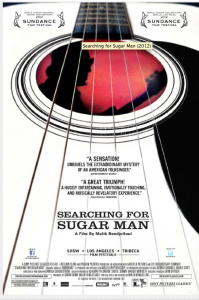
Searching For Sugarman nf -In the 1970s there was a rock singer by the name “Rodriquez†much in the style of Bob Dylan who by many accounts was as good if not better than Dylan. His lyrics were right on for the times and his voice as clear (not like BD) as a bell. He was out of Detroit and a few of the music impresarios who produced many stars of Mo-town thought he was fantastic. His story is the subject of this movie directed by Malik Bendjelloul which won the 2013 Academy Award Oscar for the best Documentary Film. Rodriquez’s music which is played throughout the film will catch your attention Take a quick listen here. For some reason he didn’t catch on and his records didn’t sell. He had played in some dives in Detroit for a while and there were rumors of his death or attempted suicide on stage. (Spoiler Alert!) He didn’t die and in fact he just faded away and for the next 25 years or so, Rodriquez lived in a modest house and worked in construction and demolition. He was a quiet hard working man who had three wonderful daughters. He still enjoyed playing on the guitar now and then but he basically melted into the woodwork as a working guy living in a depressed difficult city. However on the other side of the world in South Africa unbeknownst to him and the record producers who dumped him when he didn’t sell, his records were picked up by other labels and for many years he was “Bigger than Elvis.†His words and music became the voice of the young generation of mostly whites who felt apartheid was wrong but were suppressed by the oppressive government of South Africa. 100.000s, if not perhaps millions, of his records were sold. He received no royalties and hadn’t the slightest idea that his name was a household name there. Every young person including many of the popular musicians who became of age in the 80s and early 90s in South Africa knew his music and so many felt they were greatly influenced by it. There were a handful of people in South Africa, writers and music people, who wondered why they didn’t know more about him. Two guys tried to find out what happened and how did he die – was it really on stage? Somebody set up a website reflecting the curiosity of whatever happened to him. Lo and behold one of his daughters living in the U.S. saw the website. The story of how the people in South Africa found him and how he found South Africa will be a touching moment that you will not forget. The reunion concert with thousands of fans in ecstasy singing along with him was an amazing piece of cinema. This was a great subject for a documentary film as it allowed the viewers to share this unforgettable moment and this amazing story. (2012)
Comment » | 4 Stars, Documentary, Musical
May 29th, 2014 — 6:51am
***
Supermensch: The Legend of Shep Gordon – Various definitions would define this Yiddish word as meaning an honest, upstanding person having admirable characteristics of integrity and responsibility (and probably much more especially if you add the “super†to the word). Mike Myers, the director and producer of this film, obviously feels that way about Shep Gordon as do a great deal of other celebrities who have crossed paths with him. Early in the film we meet him as a 22 year old kid who chooses to stay in the Hollywood Motel where he has a chance encounter with Alice Cooper, Janis Joplin and Jimmy Hendrix. He begins to manage Cooper and is shown to skillfully manipulate his career to gigantic proportions. They ultimately become lifelong friends. The movie unfolds with narration by a very long list of famous people such as Michael Douglas, Sylvester Stallone, Tom Arnold, Anne Murray and many, many more, all who speak about him with great affection. There are numerous film clips of Gordon interacting with this endless A list even including Groucho Marx. His early years of sex, drugs and rock and roll was documented as well as his moving relationship with Teddy Pendergrass after he became paraplegic in a car wreck and yet was brought back to sing in a full stadium by Gordon. He was also depicted as the man who established the concept of celebrity chefs and brought these culinary experts such as Emeril Lagasse and many others to have the opportunity to reap the fame and fortune that they deserved. The supermensch was shown to be just that because he apparently had a philosophy of being loyal to his friends and sharing his great success with others. The film touched upon his upbringing and gave a hint that Gordon was developing a warm caring extended family with so many of the well known entertainers that he met perhaps because he didn’t have a very supportive family especially not his mother and his older brother. Meyers, who is well known for his comedic expertise tried to bring out the emotional underpinnings of his subject in his directorial debut. He skillfully blended in some very realistic enactments, which gave a visual flow to some of the narration. The film was fast moving and the 84 minutes did fly by as a great deal of inside show business was revealed to the viewer. The latter part of the film focused on the price that the Supermensch paid from his doing so much for others. We get the sense that despite an endless group of caring appreciative friends, he was holding in a sadness over the fact that he never had his own family. (2014)
Comment » | 3 Stars, Documentary
April 12th, 2014 — 10:44pm
***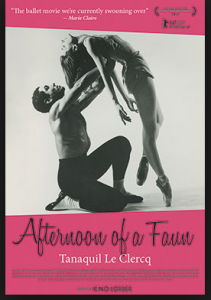
Afternoon of the Faun : Tanaquil Le Clercq rm- If you love ballet and are familiar with the great artists and choreographers  as well as the history of ballet you probably will very much enjoy this documentary film It is about a young girl who at age 14 was a talented student studying at a school run by the great Balanchine . Four years later she not only was dancing with him but soon after was married to him, although he was nearly 25 years her senior. Tanquil Le Clercq, known as “Tanny†had a long , lovely and distinctive physique. Her dancing not only inspired Balanchine but she was also said to be a muse for Jerome Robbins who created his famous Afternoon of a Faun for Tanny. She was one of the most famous dancers of her time until at the age of 27 she was struck down by polio, which was the plague of its time. This was a disease that unexpectedly would make its appearance and would especially  paralyze children and young adults. It could even be fatal. Salk’s amazing vaccine came on the scene a short time later. Tanny was forced to be in an “iron lung†which would help her breathe and then over several years graduated to a wheel chair from which she became a teacher of ballet. The film consists mostly of beautiful film clips of Tanny dancing with Balanchine and others. There are clips of people talking about this unusual woman and her life. Not only is there Balanchine and  Jerome Robbins, who was very close to her, but others such as Jacque D’Ambroise, Arthur Mitchell and a women who for many years was Balanchine’s secretary and assistant. Her insights, particularly into the thinking of her boss, captured some of the conflict that he must have had for loving and caring about Tanny, but pursuing his own career as he worked with other ballerinas, eventually leaving Tanny to marry another dancer. It is unfortunate that we never hear a meaningful interview with the main star of this film We come to care about her through the old movies of her performing her magnificent dancing and the glimpses of her beauty even in the later years. We also learn about her strength, intelligence and humor from excerpts of letters she wrote, which were read by an unseen actress in the film..  This all takes place  with the rich and melodic music of the ballet, which accompanies not only the dancing but also this moving story. If you don’t have a special relationship to ballet and dance this documentary film will probably not move you very much. But if you do, be prepared to be swept off your feet and be caught up in the true tale  of this beautiful and tragic person.(2014)
Comment » | 3 Stars, Documentary













